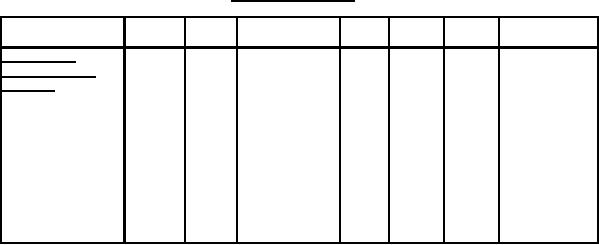
MIL-PRF-1/273K
TABLE I. Testing and inspection - Continued.
Inspection
Method
Type
Conditions
Symbol
Limits
Limits
Units
Min
Max
Conformance
inspection, part 3
continued
mm
0.75
---
W idth
Line width A
1A, 1B
---
Life test end points
mm
0.85
---
W idth
Line width B
V dc
45
---
Modulation
ĆEc
V dc
55
---
12
Ib3 = 60 µA dc;
ĆEc
modulation
mm
0.40
---
W idth
Ib3 = 5 µA dc;
Line width A
mm
0.45
---
W idth
Ib3 = 5 µA dc;
Line width B
NOTES:
1. The construction of this gun shall be the zero Ib1 type. The following information and materials are to be available with
the four regular samples when application for qualification approval is made.
(a)
The electron gun drawing with significant dimensions.
(b)
A sample of the electron gun to be used in manufacture of tubes.
2. This test to be performed at the conclusion of the holding period.
3. The test is made with maximum voltage (Eg1 maximum negative voltage) applied to the base pins, and deflection
electrodes if applicable, only; and pressure of 87 mmHg. Connections should be made in a manner that does not
degrade the tubes electrical voltage breakdown characteristics. Satisfactory operation is the absence of arc-over and
corona.
4. P12 screen. The tube can be severely and permanently damaged if the current density on the screen is allowed to rise
too high in static tests of this sort . For this reason the length of time during which the screen is bombarded should be
kept as short as possible compatible with the readings of specified current limits.
5. The deflecting plates shall be returned to anode No. 2 through a minimum of 2.5-megohm resistors. The light output
shall be set at 15-ft lamberts (51.4 cd/m2). The high-frequency scanning shall be applied to the deflecting plates
nearest to the screen and the amplitude shall be adjusted to give a length of approximately 90 percent of the maximum
tube diameter. The low-frequency scanning amplitude shall be expanded to approximately 90 percent of the maximum
tube diameter, in the direction perpendicular to the direction of high-frequency scanning. Readjustments may be made
for best overall focus. The tubes shall be observed for deflection focusing, astigmatism, or spot ellipticity observable to
the eye as evidenced by fuzziness due to the lack of sharpness of trace (usually around edges), bow-tying (irregular
width of any single line when observed at different points), bowing of trace, other than that caused by curvature of
bulb. Such defects shall not be excessive as determined by the government representative. This test for focus is to be
made in addition to the line width measurements.
6. The same conditions shall be set up as described in note 5, except that the connection of deflecting elements to the
low- and high-frequency scanning supplies shall be interchanged and the amplitudes adjusted to 90 percent of the
maximum tube diameter in both directions without any adjustments of focus. An examination for defocusing,
astigmatism, or spot ellipticity shall be made as in note 6 and the defocusing, astigmatism, etc., shall not be excessive
as determined by a Government representative .
7. P12 screen. All tests except screen persistence and fluorescent brightness can be made at 50 percent duty cycle
pulsing .
8. Revision letters are not used to denote changes due to the extensiveness of the changes .
9. This specification sheet uses accept on zero defect sampling plan in accordance with MIL-PRF-1, table III.
5